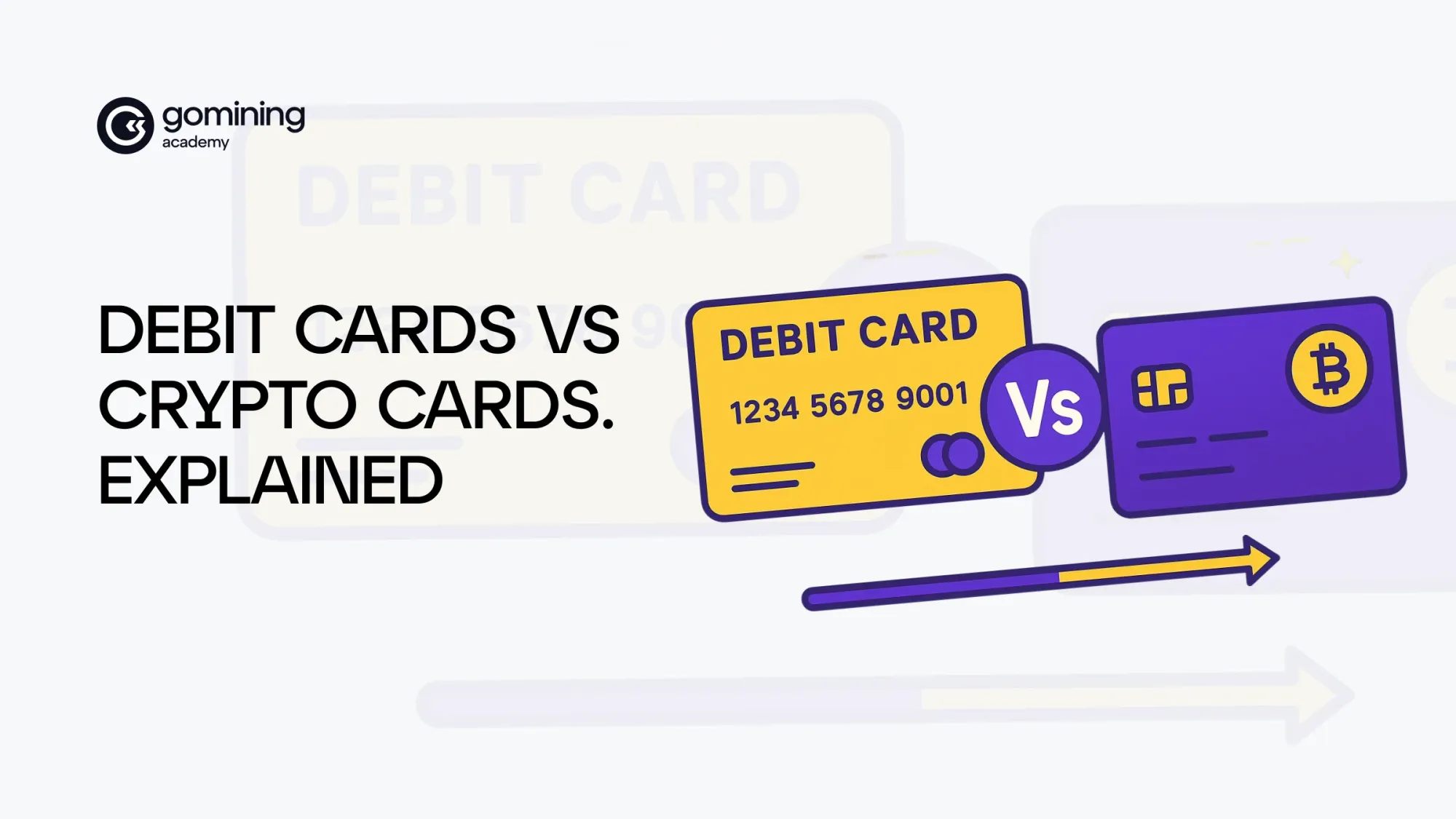How to Choose a Crypto Wallet: 2025 Edition
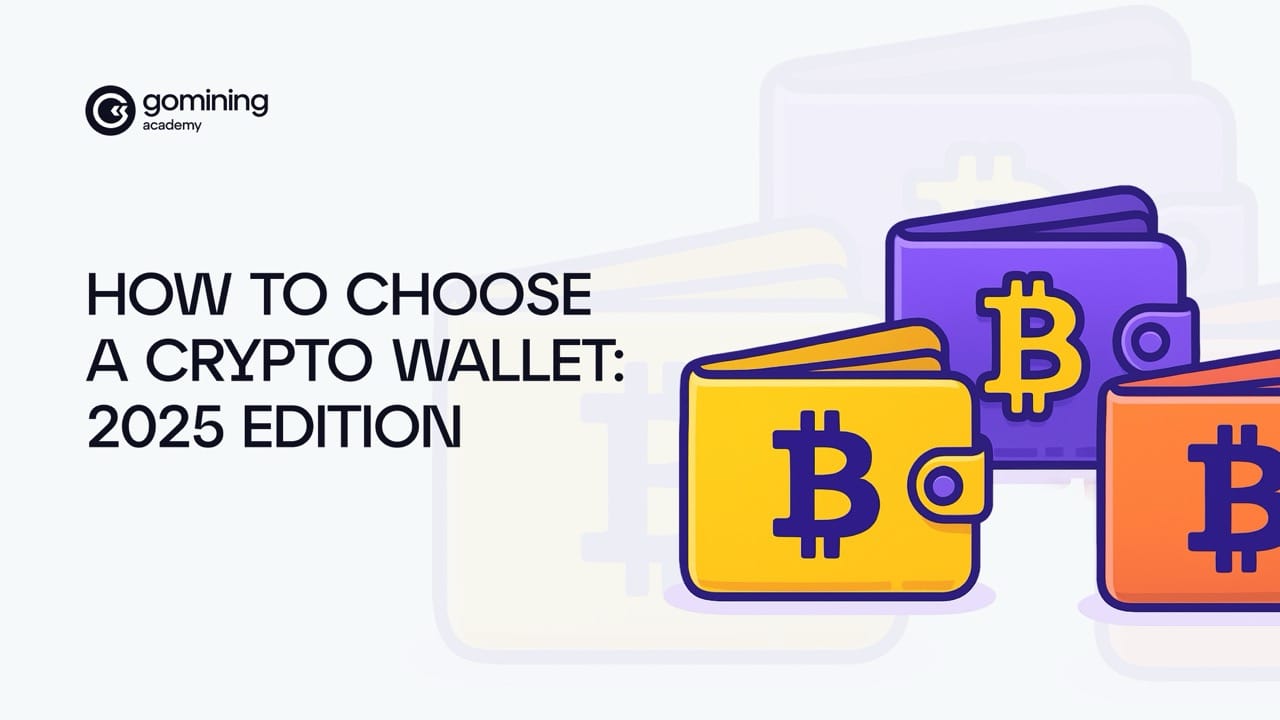
Table of Contents:
- What Is a Crypto Wallet?
- No Emails, No Personal Data: Setting Up a Crypto Wallet
- Recovering Access with Your Seed Phrase
- Important Seed Phrase Tips
- Add a Personal Touch: Naming Your Wallet
- Hot Wallets vs. Cold Wallets: Spend Freely or Sleep Easy?
- Custodial vs. Non-Custodial: Who’s Really in Control?
- How to Access Your Crypto Wallet: A Closer Look
- Security Tips & Scam Red Flags for Wallets
- Top 10 Crypto Wallets of 2025: Features & Use Cases
- Critical Considerations for 2025
- GoMining: Where Your Crypto Wallet Does More Than Just Store Coins
- Conclusion: Wallet = Freedom
Crypto can feel like the Wild West of finance – thrilling but a bit lawless. Before you ride off into the sunset with your hard-earned coins, you need a trusty crypto wallet. But which wallet is best for storing your crypto?
With dozens of good crypto wallets on the market, selecting one can be confusing. Don’t panic – GoMining Academy has your back.
We’ll walk you through exactly how to choose a crypto wallet step-by-step, explain key differences (hot vs. cold, custodial vs. non-custodial),and even compare the top 10 crypto wallets of 2025 in a handy table.
By the end, you’ll not only know which cryptocurrency wallet is best for you, but also understand how your wallet truly is your digital freedom card in Web3.
What Is a Crypto Wallet?
In crypto, your wallet isn’t just a container for coins—it’s a vault, a passport, and a bodyguard all in one.
Unlike a regular wallet that holds cash, a crypto wallet doesn’t actually store your crypto. Your coins and tokens live on the blockchain—an enormous public ledger. What your wallet really holds is your private key and your public key.
The public key is safe to share. It acts like your crypto username and lets others send funds to you or interact with your wallet. It is usually a long string like 0xF34...CryptoHuman
Your private key, on the other hand, is a powerful, one-of-a-kind digital signature. It silently proves you own your crypto and lets you send it to others, without ever revealing your identity. If someone else gets their hands on that key, they can impersonate you and empty your wallet. If you lose the key altogether, your funds are stuck on the blockchain forever—unreachable, like a treasure chest without a key.
No Emails, No Personal Data: Setting Up a Crypto Wallet
In the traditional internet (Web2), your identity is tied to things like your name, email, and password. You hand over personal details to create an account and log in. But Web3 flips the script. Most often a crypto wallet lets you jump in with zero friction—no sign-ups, no phone numbers, no forms to fill. Just you, a few clicks, and the cryptographic keys to your own slice of the internet.
Here’s how it typically unfolds:
- Choose a Crypto Wallet Provider:
Whether it’s MetaMask for browser-based dApps, Trust Wallet for mobile ease, or Ledger for hardware-level protection, pick a wallet that matches your goals. If you’re still wondering how to choose a wallet for crypto, don’t worry—we’ve got a crypto wallets list and tips on trusted crypto wallets further down. - Generate Your Wallet:
The wallet’s software creates a unique pair of cryptographic keys: your public key and your private key. - Start Transacting:
Once set up, you can send and receive crypto, interact with dApps, buy NFTs, and explore Web3.
🔁 Recovering Access with Your Seed Phrase
Regardless of the crypto wallet type, if you lose access to your device or forget your password, you can restore your wallet using your seed phrase—a sequence of 12 or 24 words generated when you first set up the wallet. This applies to all the best crypto wallets and most popular crypto wallets you’ll encounter.
Important Seed Phrase Tips:
- Store Securely: Write down your seed phrase and store it in a secure, offline location. Avoid saving it digitally to prevent hacking risks.
- One-Time Use: Your seed phrase is the master key to your wallet. Anyone with access to it can control your funds.
- No Recovery Without It: If you lose your seed phrase, there's no way to recover your wallet or its contents.
Read seed phrase vs private key if you want to explore in further detail their differences.
Add a Personal Touch: Naming Your Wallet
Long alphanumeric wallet addresses are nobody’s idea of a good time. Enter services like Ethereum Name Service (ENS), which let you register a human-readable name (like yourname.eth). This makes sharing and remembering wallet addresses way easier—and adds a little personality to your crypto identity. Many of the top crypto wallets support these naming services, so consider them when choosing a crypto wallet.
Hot Wallets vs. Cold Wallets: Spend Freely or Sleep Easy?
A crypto wallet can come in all shapes and temperatures—but the biggest divide is hot vs. cold
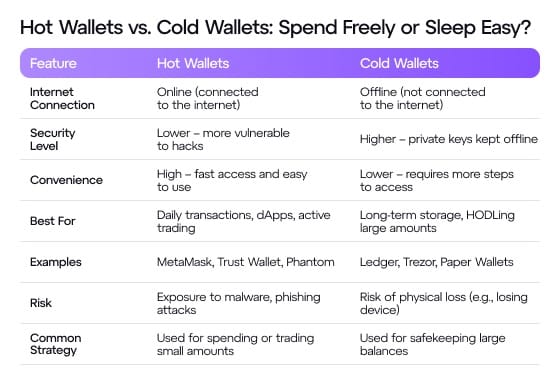
Still not sure which is the best wallet for crypto—a cold wallet or a mobile app? This guide from Blockchain Council offers a list of crypto wallets and a breakdown of how each fits into your crypto journey
Custodial vs. Non-Custodial: Who’s Really in Control?
Custody is everything. It’s the difference between holding your keys and hoping someone else doesn’t lose them.
- Non-Custodial Wallets:
You hold your private keys. You’re the boss. No one can access your assets without that key. But lose it, and they’re gone forever. Many of the best crypto wallets 2025 are non-custodial.
- Custodial Wallets:
A company (like an exchange, such as Coinbase or Binance) holds the keys for you. You log in with a password, and they handle the rest. Easier—but you’re trusting them with your crypto.
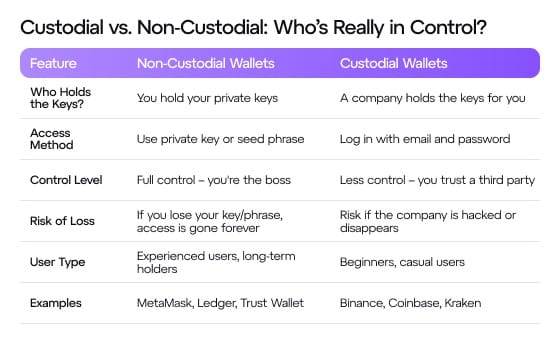
Pro tip? Many newbies start with custodial wallets (Binance, Coinbase), but veterans often move to non-custodial ones for full ownership.
As they say: not your keys, not your coins. For a deep dive into custody check this link: What is crypto custody?
🔓 How to Access Your Crypto Wallet: A Closer Look
Accessing your crypto wallet depends on the type you've chosen. Here's how each works, along with some practical tips:
📱 Mobile Wallets (e.g., Trust Wallet, Zengo)
- Access Method: Open the app on your smartphone and unlock it using a PIN, fingerprint, or Face ID.
- What's Happening: The app stores your encrypted private key on your device. When you initiate a transaction, the app uses this key to sign it, verifying your ownership without exposing the key itself.
- Pros: Great for daily use, especially with popular crypto wallets that offer user-friendly experiences, and interacting with decentralized applications (dApps).
- Cons: If your phone is lost or compromised, your wallet could be at risk. Always enable security features and back up your seed phrase.
🧩 Browser Extension Wallets (e.g., MetaMask)
Several top crypto wallets are browser-based.
- Access Method: Click on the wallet icon in your browser toolbar and enter your password to unlock.
- What's Happening: The extension stores your encrypted private key in your browser's local storage. Upon unlocking, it uses this key to sign transactions.
- Pros: Seamless integration with web-based dApps and DeFi platforms.
- Cons: Browsers can be vulnerable to phishing attacks and malware. Ensure your browser is up-to-date and consider using additional security measures.
🔐 Hardware Wallets (e.g., Ledger, Trezor)
- Access Method: Connect the hardware wallet to your computer or mobile device via USB or Bluetooth. Enter your PIN directly on the device to unlock it.
- What's Happening: Your private key never leaves the hardware wallet. When you initiate a transaction, the device signs it internally and sends the signed transaction back to your computer or mobile device.
- Pros: Highest security, often cited in every “best crypto wallets” article, for keeping your private key offline.
- Cons: Less convenient for frequent transactions. If the device is lost or damaged, recovery requires your seed phrase.
Security Tips & Scam Red Flags for Wallets
Your crypto wallet holds the keys to your fortune. Here are some beginner-friendly security tips and red flags to stay safe:
- Safeguard Your Seed Phrase: When you first set up a non-custodial wallet, it gives you a 12- or 24-word recovery phrase. It's good to write it down on paper(not on a screenshot or cloud note!) and store it in a safe place. If you lose this phrase, nobody can help you recover your crypto wallet. Treat it like the key to a vault.
- Use Hardware for Big Savings: Consider putting the bulk of your crypto in a hardware (cold) wallet. That way, even if your phone or computer is compromised, your main stash is still locked away offline.
- Enable Security Features: Choose a crypto wallet with extra locks. Enable PIN codes or biometrics on mobile wallets. Use 2FA where available. Only download official wallet apps or extensions (double-check website URLs).
- Beware of Phishing & Scams: Never click random links promising free crypto “giveaways.” Always visit official wallet sites or app stores. If someone asks you to share your private keys or seed phrase — run away. Always double-check you are on the real site/extension, as scammers often make lookalike pages.
- Test with Small Amounts: When trying a new crypto wallet, send just a tiny amount of crypto first to make sure the address is correct and everything works, before moving your full balance.
- Watch Out for Too-Good-To-Be-True: If a crypto wallet or service claims it will double your coins or guarantees massive returns, it’s almost certainly a scam. Similarly, be cautious of any “new wallet” that’s not reviewed or audited.
- Keep Software Updated: Whether it’s your mobile wallet app or your computer’s antivirus, keep everything up to date. Updates often patch security holes.
🔒 Pro Tip: Remember that with non-custodial wallets, you’re totally on your own. That’s great for control, but it means you must take precautions. As Ledger’s guide warns, losing your keys = losing your coins. So store your keys securely and verify every transaction.
With great wallet power... comes even greater responsibility.
Top 10 Crypto Wallets of 2025: Features & Use Cases
Here’s a quick look at the top 10 crypto wallets—covering everything from beginner favorites to security powerhouses. If you want to know which wallet is best for crypto or just need the best crypto wallet for your needs, start here:
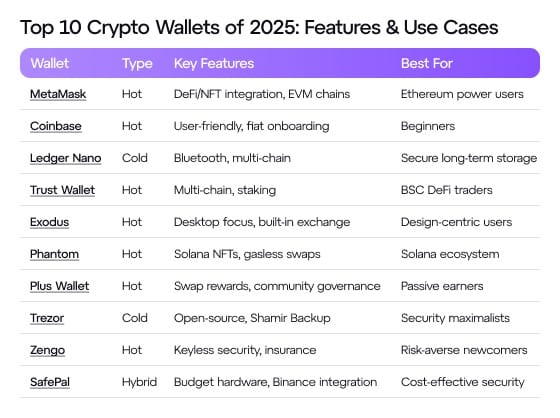
This list of crypto wallets offers something for everyone—whether you want the best crypto wallets 2025 for DeFi, NFTs, or just simple, secure storage.
Critical Considerations for 2025
- Security: Hardware wallets like Ledger and Trezor remain the gold standard among cryptocurrency wallets for large holdings, while hot wallets like MetaMask and Phantom prioritize DeFi accessibility.
- Earnings: Some of the best crypto wallets offer integrated staking. Wallets like “Swap to Earn” and Exodus’ provide staking rewards that reflect a trend toward integrated income streams.
- Interoperability: Multi-chain support is now table stakes, with leaders like Trust Wallet and MetaMask enabling cross-chain swaps.
By aligning wallet choice with use case - whether DeFi participation, NFT collection, or secure storage - users can navigate 2025’s Web3 ecosystem confidently.
Conclusion: Wallet = Freedom
In Web3, your wallet isn’t just a tool—it’s your identity, your bank, and your passport to the digital frontier. Owning it means owning your place in the new Internet. Choosing a crypto wallet isn’t just about tech—it’s about freedom and responsibility. Your wallet is the key to your digital kingdom.
Now that you’ve read this guide, you know the lay of the land: what crypto wallets are, how hot vs cold and custodial vs non-custodial differ, and which wallet features fit your style.
Armed with our crypto wallets list and knowledge, you can confidently pick the best wallet that works for you.
Will you go for user-friendly convenience (hello, Trust Wallet and Coinbase Wallet), or max security (Ledger/Trezor)? The choice is yours, and the power is in your hands.
Ready to take your wallet for a spin? Connect it to GoMining’s dashboard and explore how digital mining, GameFi, and NFTs can turn your wallet into a tool for both security and growth. Curious about the real numbers? Our blog breaks down the latest profitability trends so you can mine smarter, not harder.
🔑 Your wallet is your key — keep it safe, use it wisely, and enjoy the ride to financial freedom.

